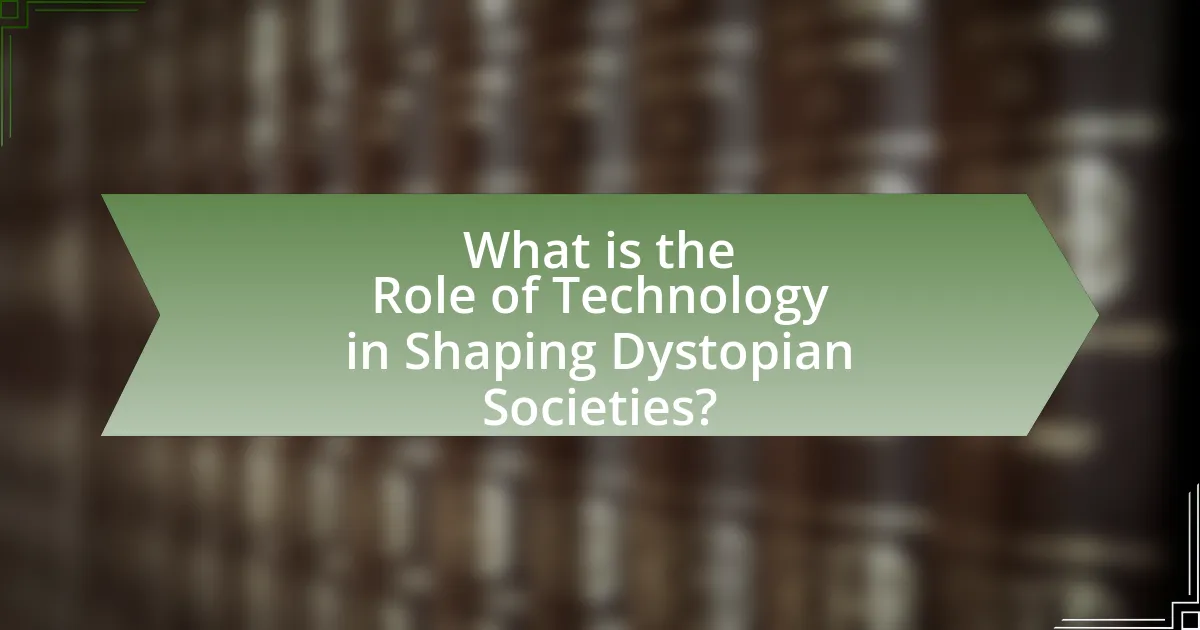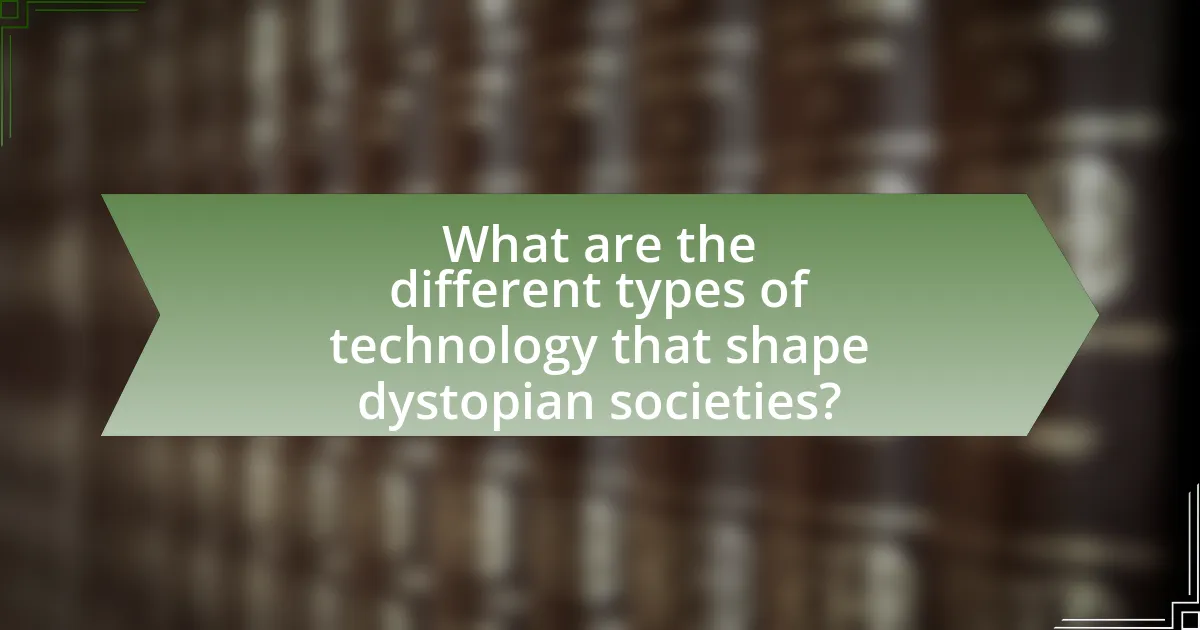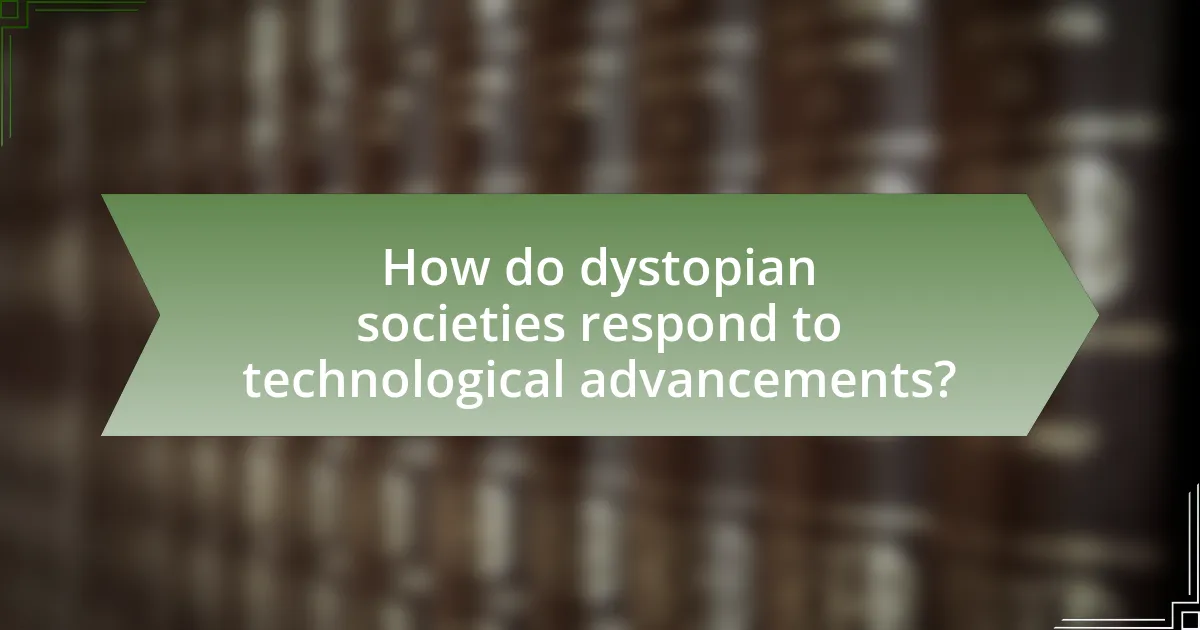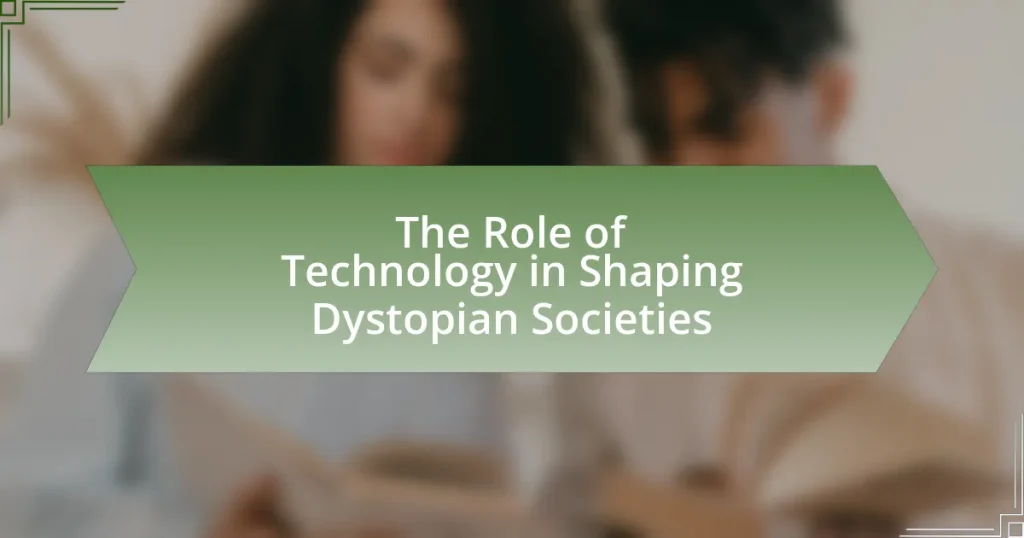The article examines the pivotal role of technology in shaping dystopian societies, highlighting how advancements such as surveillance systems, artificial intelligence, and biotechnology facilitate control, manipulation, and oppression. It discusses key examples, including George Orwell’s “1984” and China’s social credit system, illustrating the impact of technology on individual freedoms and societal norms. The article also explores the ethical concerns surrounding these technologies, the responses of dystopian regimes to technological advancements, and the strategies individuals employ to navigate oppressive environments. Ultimately, it emphasizes the need for ethical frameworks and public engagement to prevent dystopian outcomes in contemporary society.

What is the Role of Technology in Shaping Dystopian Societies?
Technology plays a crucial role in shaping dystopian societies by enabling surveillance, control, and manipulation of populations. For instance, in George Orwell’s “1984,” the use of telescreens exemplifies how technology facilitates constant monitoring, suppressing individual freedoms and promoting conformity. Additionally, real-world examples such as China’s social credit system illustrate how technology can enforce compliance and social order through data collection and analysis, impacting citizens’ behavior and choices. These instances demonstrate that technology can serve as a tool for authoritarian regimes to maintain power and influence over society, ultimately contributing to the characteristics of a dystopian environment.
How does technology contribute to the development of dystopian societies?
Technology contributes to the development of dystopian societies by enabling surveillance, control, and manipulation of individuals. Advanced surveillance systems, such as facial recognition and data tracking, allow governments and corporations to monitor citizens continuously, leading to a loss of privacy and autonomy. For instance, China’s Social Credit System exemplifies how technology can enforce compliance and punish dissent through real-time data collection and analysis. Additionally, the proliferation of misinformation through social media platforms can manipulate public perception and stifle dissent, further entrenching authoritarian regimes. These technological advancements create environments where individual freedoms are suppressed, and societal norms are dictated by those in power.
What are the key technological advancements that influence dystopian settings?
Key technological advancements that influence dystopian settings include surveillance technology, artificial intelligence, biotechnology, and advanced weaponry. Surveillance technology, such as facial recognition and data mining, enables authoritarian regimes to monitor and control populations, as seen in George Orwell’s “1984.” Artificial intelligence can lead to job displacement and social stratification, exemplified by the automation trends in contemporary society. Biotechnology raises ethical concerns regarding genetic manipulation and human enhancement, as depicted in works like Aldous Huxley’s “Brave New World.” Advanced weaponry, including drones and cyber warfare capabilities, can escalate conflicts and maintain oppressive control, reflecting real-world military developments. These technologies collectively shape the oppressive environments characteristic of dystopian narratives.
How do these advancements alter social structures and norms?
Advancements in technology significantly alter social structures and norms by reshaping communication, power dynamics, and individual behavior. For instance, the rise of social media platforms has transformed interpersonal communication, leading to a shift from face-to-face interactions to digital exchanges, which can foster isolation and change community engagement. Additionally, surveillance technologies have concentrated power in the hands of authorities, altering trust dynamics between citizens and governments, as seen in countries with extensive monitoring systems like China. These changes can lead to a normalization of privacy invasion and a culture of compliance, as individuals adapt their behaviors to align with perceived societal expectations influenced by technological capabilities.
Why is technology often depicted as a tool of oppression in dystopian narratives?
Technology is often depicted as a tool of oppression in dystopian narratives because it enables surveillance, control, and manipulation of individuals by authoritarian regimes. In these narratives, advanced technologies such as surveillance cameras, data analytics, and artificial intelligence are utilized to monitor citizens, suppress dissent, and maintain power. For instance, George Orwell’s “1984” illustrates how the government employs telescreens to invade privacy and enforce conformity, demonstrating the potential of technology to facilitate totalitarian control. This portrayal reflects societal fears about the misuse of technology, particularly in contexts where it can undermine personal freedoms and autonomy.
What examples illustrate technology’s role in surveillance and control?
Technology plays a crucial role in surveillance and control through various systems and tools. For instance, facial recognition technology is widely used by governments and corporations to monitor individuals in public spaces, enabling real-time identification and tracking. A notable example is China’s Social Credit System, which utilizes data from various sources to assess citizens’ behavior and assign scores that influence their access to services and opportunities. Additionally, mass data collection practices by companies like Facebook and Google allow for targeted surveillance and manipulation of user behavior, as seen in the Cambridge Analytica scandal, where personal data was exploited for political advertising. These examples demonstrate how technology facilitates extensive monitoring and control over populations, shaping societal dynamics in significant ways.
How does technology facilitate the manipulation of information?
Technology facilitates the manipulation of information by enabling rapid data processing, dissemination, and alteration through digital platforms. Digital tools such as algorithms, artificial intelligence, and social media allow for the selective presentation of information, influencing public perception and behavior. For instance, algorithms can prioritize certain news articles over others, shaping the narrative that users encounter. Additionally, technologies like deepfakes and data analytics can distort reality by creating misleading content or targeting specific demographics with tailored misinformation. The Cambridge Analytica scandal exemplifies this, where data from millions of Facebook users was harvested to influence voter behavior in the 2016 U.S. presidential election, demonstrating the profound impact of technology on information manipulation.

What are the different types of technology that shape dystopian societies?
Different types of technology that shape dystopian societies include surveillance systems, artificial intelligence, biotechnology, and advanced weaponry. Surveillance systems, such as facial recognition and mass data collection, enable governments to monitor citizens extensively, leading to a loss of privacy and autonomy. Artificial intelligence can control and manipulate information, influencing public perception and behavior, as seen in social media algorithms that prioritize certain narratives. Biotechnology, including genetic engineering and biohacking, raises ethical concerns about human enhancement and societal inequality. Advanced weaponry, such as drones and autonomous military systems, can enforce oppressive regimes and escalate conflicts. These technologies collectively contribute to the oppressive structures characteristic of dystopian societies.
How do communication technologies impact societal dynamics in dystopias?
Communication technologies in dystopias often serve to reinforce authoritarian control and manipulate societal dynamics. These technologies enable surveillance, disseminate propaganda, and restrict free expression, thereby shaping public perception and behavior. For instance, in George Orwell’s “1984,” the telescreens monitor citizens continuously, ensuring compliance and suppressing dissent. This illustrates how communication technologies can create an environment of fear and conformity, ultimately undermining individual autonomy and fostering a culture of obedience. Additionally, in contemporary discussions, the use of social media algorithms to spread misinformation demonstrates how communication technologies can distort reality and polarize societies, further entrenching divisions and complicating social cohesion.
What role does social media play in shaping public perception?
Social media significantly influences public perception by rapidly disseminating information and shaping narratives. Platforms like Twitter and Facebook allow users to share opinions, news, and personal experiences, which can create echo chambers that reinforce existing beliefs. Research indicates that 62% of adults obtain news from social media, highlighting its role as a primary information source. Additionally, algorithms prioritize content that generates engagement, often amplifying sensational or polarizing messages, which can distort public understanding of issues. This phenomenon has been observed in various contexts, such as political campaigns and social movements, where social media has been pivotal in mobilizing support or opposition.
How can communication technologies be used for propaganda?
Communication technologies can be used for propaganda by disseminating information rapidly and widely to influence public opinion. These technologies, such as social media platforms, television, and radio, enable the targeted distribution of messages that can manipulate perceptions and beliefs. For instance, during the 2016 U.S. presidential election, social media was utilized to spread misinformation and polarizing content, significantly impacting voter behavior and public discourse. Studies have shown that exposure to biased information on these platforms can reinforce existing beliefs and create echo chambers, further entrenching divisive narratives.
What is the impact of artificial intelligence on dystopian societies?
Artificial intelligence significantly impacts dystopian societies by enhancing surveillance, controlling information, and perpetuating social inequalities. In such societies, AI technologies are often employed to monitor citizens, as seen in countries like China, where facial recognition systems are used to track individuals and suppress dissent. Additionally, AI algorithms can manipulate information dissemination, creating echo chambers that reinforce authoritarian narratives, thereby limiting access to diverse viewpoints. Furthermore, the automation of jobs through AI exacerbates economic disparities, leading to increased unemployment and social unrest. These dynamics illustrate how AI can entrench existing power structures and contribute to the overall oppression characteristic of dystopian environments.
How does AI contribute to decision-making processes in oppressive regimes?
AI enhances decision-making processes in oppressive regimes by enabling data-driven surveillance, predictive policing, and automated censorship. These technologies allow governments to monitor citizens’ activities, analyze behavioral patterns, and preemptively identify dissent. For instance, China’s use of AI in its social credit system exemplifies how data analytics can influence individual behavior and enforce compliance through rewards and punishments. Additionally, AI algorithms can process vast amounts of information to identify potential threats, thereby streamlining law enforcement responses. This integration of AI into governance not only increases efficiency but also consolidates power by minimizing human error and bias in decision-making.
What ethical concerns arise from the use of AI in these contexts?
The ethical concerns arising from the use of AI in shaping dystopian societies include issues of privacy, bias, accountability, and autonomy. Privacy is compromised as AI systems often require extensive data collection, leading to surveillance and loss of individual freedoms. Bias manifests when AI algorithms reflect and perpetuate societal prejudices, resulting in discriminatory outcomes in areas like hiring and law enforcement. Accountability becomes problematic when decisions made by AI systems lack transparency, making it difficult to determine responsibility for harmful actions. Lastly, autonomy is threatened as AI can manipulate choices and behaviors, undermining individual agency. These concerns are supported by studies, such as the 2019 report by the AI Now Institute, which highlights the risks of biased algorithms and the need for ethical frameworks in AI deployment.

How do dystopian societies respond to technological advancements?
Dystopian societies typically respond to technological advancements with increased surveillance and control over their populations. For instance, in George Orwell’s “1984,” the government employs telescreens to monitor citizens constantly, illustrating how technology is used to suppress dissent and maintain authority. Additionally, these societies often manipulate technology to propagate propaganda, as seen in Aldous Huxley’s “Brave New World,” where advancements in reproductive technology and conditioning are utilized to enforce conformity and eliminate individuality. Such responses highlight the dual nature of technology in dystopian contexts, serving both as a tool for oppression and a means to maintain societal order.
What measures do governments take to control technology in dystopian settings?
Governments in dystopian settings implement various measures to control technology, including surveillance, censorship, and regulation of information. Surveillance systems, such as cameras and data monitoring, are often deployed to track citizens’ activities and communications, as seen in George Orwell’s “1984,” where the Party uses telescreens to maintain constant oversight. Censorship is another critical measure, where governments restrict access to information and manipulate media to shape public perception, exemplified by the Ministry of Truth in the same novel. Additionally, regulations may be enforced to limit the development and use of technologies that could empower individuals or challenge state authority, as illustrated by the banning of certain technologies in Ray Bradbury’s “Fahrenheit 451.” These measures collectively serve to suppress dissent and maintain control over the populace.
How do laws and regulations evolve in response to new technologies?
Laws and regulations evolve in response to new technologies through a process of adaptation that addresses emerging challenges and risks. As technologies such as artificial intelligence, biotechnology, and digital communication develop, lawmakers assess their societal impacts, leading to the creation or modification of legal frameworks. For instance, the rise of the internet prompted the enactment of data protection laws like the General Data Protection Regulation (GDPR) in the European Union, which was established to safeguard personal data in the digital age. This evolution is often driven by public concerns, ethical considerations, and the need to balance innovation with safety and privacy, demonstrating that legal systems must remain dynamic to effectively govern technological advancements.
What role do resistance movements play against technological oppression?
Resistance movements play a crucial role in combating technological oppression by advocating for digital rights, privacy, and equitable access to technology. These movements mobilize individuals and communities to challenge oppressive systems that exploit technology for surveillance, control, and discrimination. For instance, the Electronic Frontier Foundation has actively fought against government surveillance and censorship, highlighting the importance of protecting civil liberties in the digital age. Additionally, movements like the Arab Spring utilized social media to organize protests against authoritarian regimes, demonstrating how technology can be repurposed as a tool for liberation rather than oppression.
How do individuals adapt to technology in dystopian environments?
Individuals adapt to technology in dystopian environments by developing new skills and strategies to navigate oppressive systems. For instance, in George Orwell’s “1984,” citizens learn to manipulate surveillance technology to evade detection, showcasing their ability to innovate under constraints. Additionally, studies indicate that individuals often form underground networks to share information and resources, as seen in various historical contexts where technology was used for resistance, such as during the Arab Spring. This adaptability highlights the resilience of human behavior in the face of technological control and societal challenges.
What strategies do people use to navigate surveillance and control?
People employ various strategies to navigate surveillance and control, including the use of encryption, anonymity tools, and social engineering tactics. Encryption software, such as Signal or WhatsApp, allows individuals to communicate securely, protecting their conversations from unauthorized access. Anonymity tools like VPNs and Tor enable users to mask their online identities, making it difficult for surveillance systems to track their activities. Additionally, social engineering tactics, such as creating false identities or using misdirection, help individuals evade detection and manipulate surveillance systems. These strategies are increasingly relevant in a world where technology plays a significant role in monitoring and controlling behavior, as evidenced by the rise in privacy-focused applications and the growing awareness of digital rights among users.
How does technology influence personal relationships and community bonds?
Technology significantly influences personal relationships and community bonds by facilitating communication and altering social interactions. For instance, social media platforms enable individuals to connect across vast distances, fostering relationships that may not have developed otherwise. However, studies indicate that while technology can enhance connectivity, it may also lead to superficial interactions, reducing the depth of personal relationships. Research from the Pew Research Center shows that 70% of adults believe technology has made it easier to stay in touch with friends and family, yet 40% feel that it has made face-to-face interactions less meaningful. This dual impact illustrates how technology can both strengthen and weaken community bonds, creating a complex dynamic in personal relationships.
What lessons can we learn from the role of technology in dystopian societies?
The primary lesson from the role of technology in dystopian societies is that technology can be a tool for oppression and control. In many dystopian narratives, such as George Orwell’s “1984,” surveillance technology is used to monitor and manipulate citizens, illustrating how advancements can lead to a loss of privacy and autonomy. Additionally, the use of artificial intelligence and data analytics in these societies often serves to reinforce authoritarian regimes, as seen in Aldous Huxley’s “Brave New World,” where technology is employed to condition and pacify the population. These examples highlight the critical need for ethical considerations and safeguards in technological development to prevent misuse and protect individual freedoms.
How can these insights inform our approach to technology today?
Insights into the role of technology in shaping dystopian societies can inform our approach to technology today by highlighting the potential risks and ethical considerations associated with technological advancements. For instance, historical examples such as the surveillance state in George Orwell’s “1984” illustrate how technology can be used to infringe on personal freedoms and privacy. This understanding emphasizes the need for robust regulations and ethical frameworks to govern technology deployment, ensuring that innovations serve societal good rather than contribute to oppression. Furthermore, studies like the Pew Research Center’s report on technology and society indicate that public perception of technology’s impact is increasingly wary, suggesting that transparency and accountability in tech development are crucial for fostering trust and preventing dystopian outcomes.
What best practices can be adopted to prevent dystopian outcomes?
To prevent dystopian outcomes, implementing robust ethical guidelines for technology development is essential. Establishing frameworks that prioritize human rights, transparency, and accountability in technological advancements can mitigate risks associated with misuse. For instance, the Asilomar AI Principles advocate for the responsible development of artificial intelligence, emphasizing safety and ethical considerations. Additionally, fostering public engagement and interdisciplinary collaboration in technology policy can ensure diverse perspectives are considered, reducing the likelihood of oppressive systems emerging. Historical examples, such as the backlash against surveillance technologies in various countries, demonstrate the importance of public discourse in shaping technology’s role in society.




